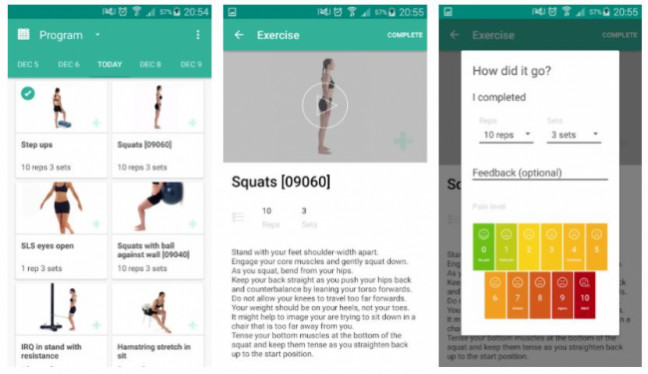| Physitrack and PhysiApp apps | By Physitrack Limited |
|
Features
|
|
| Clinical review |
|
| Security and privacy | Does the app:
Read more about safety and security when using apps. Brochures: |
| Cost | Free |
| How to get the app | PhysiTrack(external link) or PhysiApp(external link) |
Love our website? We do too. Did you know we're a charity? Donate now to help us keep it free for everyone in Aotearoa New Zealand.
Physitrack and PhysiApp apps
Physitrack and PhysiApp apps
- Physitrack and PhysiApp are companion apps for home exercises. Physitrack is the clinician portal and PhysiApp is the patient portal.

Physitrack and PhysiApp are companion apps:
- Physitrack is the clinician portal and is available on web and Apple only
- PhysiApp is the patient portal and is available on web Android and Apple.
Physitrack enables clinicians to prescribe exercises for their patients and to monitor their progress remotely. Clinicians can select and combine exercises, pre-made templates, educational content and outcome measurements into an exercise prescription programme for sending digitally to their patients or generating as a PDF.
Through the PhysiApp portal, patients can access the exercises prescribed to them by their healthcare provider. They can follow along with the exercises in their app, which has an integrated timer, and give feedback to the clinician for each individual exercise. The videos are well narrated with detailed descriptions and videos of how to perform them correctly.
For the complete app description, go to the app website, PhysiTrack(external link) or PhysiApp(external link) or, for a more detailed review, see reviews below.

| PROS | CONS |
|---|---|
|
✔ The clinician can select and combine exercises, premade templates, educational content and outcome measurements into an exercise prescription programme for sending digitally or generating as a PDF. |
✘ The patient portal PhysiApp is available on Android but has multiple reports of bugginess, including in our own testing. |
Clinical review
![]()
Reviewer: Jeremy Steinberg, GP, FRNZCGP
Date of review: January 2021
Version: Accessed 18/1/21
Comments: Physitrack is a highly polished clinician app that works alongside the PhysiApp patient app. It allows clinicians to create digital exercise prescriptions and monitor patient progress. It has an impressively large library of exercises. Online consultations are also available as an extra paid service. I am discouraged by the apparent lack of out-of-the box evidence-based templates. For example, there is no template that follows the LEAP trial protocol for gluteal tendinopathy, no template for the Holmgren subacromial pain protocol, etc. The clinician can create their own template, but this is a missed opportunity for spreading evidence-based practice. As it stands, there is probably a high chance of a patient not receiving an evidence-based template programme where one exists, unless the clinician is very diligent in creating their own custom templates based on research.
There has been some published research on the use of Physitrack. It remains to be seen whether Physitrack, with or without the addition of remote support, results in any meaningful improvements in adherence or outcome measures. One study in children with cerebral palsy showed similar adherence rates and outcomes measures compared to traditional paper based methods.¹ Another trial looking at adults with a range of conditions compared Physitrack to mixed methods of programme delivery (written, verbal, demonstration, observation), and there was a very small benefit in the group that were assigned to Physitrack, with questionable clinical significance.² Overall, when compared to usual care physiotherapy, the evidence thus far does not suggest any significant or clinically meaningful improvements in adherence or outcomes when using this platform.
However, this tool could be invaluable in settings where access to physiotherapy is limited, eg, due to cost, service constraints or regional isolation. One study compared prehabilitation using Physitrack vs no prehabilitation for patients undergoing total knee replacement surgery. The prehabilitation group had a reduced length of stay in hospital with associated reduced overall costs.³ It would be interesting to see this sort of cost benefit analysis done in New Zealand urban and rural communities, taking into account both ACC co-payments and patient time off work when seeing the clinician.
Safety concerns: None.
New Zealand relevance: It is a global product, and they officially support New Zealand. The product does not integrate with all practice management software systems in use in New Zealand.
References
- Johnson RW et al. Can an online exercise prescription tool improve adherence to home exercise programmes in children with cerebral palsy and other neurodevelopmental disabilities? A randomised controlled trial(external link)(external link) BMJ Open. 2020 Dec 22;10(12):e040108.
- Bennell KL et al. Does a web-based exercise programming system improve home exercise adherence for people with musculoskeletal conditions? A randomized controlled trial(external link)(external link) Am J Phys Med Rehabil. 2019 Oct;98(10):850-858.
- Bogue E, et al. Digital prehabilitation reduces length of stay in patients who undergo total knee arthroplasty(external link)(external link) Orthopaedic Proceedings. 17 April 2018
|
Disclaimer: The NZ Health App Library is a free consumer service to help you decide whether a health app would be suitable for you. Our review process is independent. We have no relationship with the app developers or companies and no responsibility for the service they provide. This means that if you have an issue with one of the apps we have reviewed, you will need to contact the app developer or company directly. |
Factsheets – using health apps safely

How to choose a health app
Healthify He Puna Waiora, NZ

Privacy and security tips for using health apps
Healthify He Puna Waiora, NZ
Credits: Healthify editorial team. Healthify is brought to you by Health Navigator Charitable Trust.


